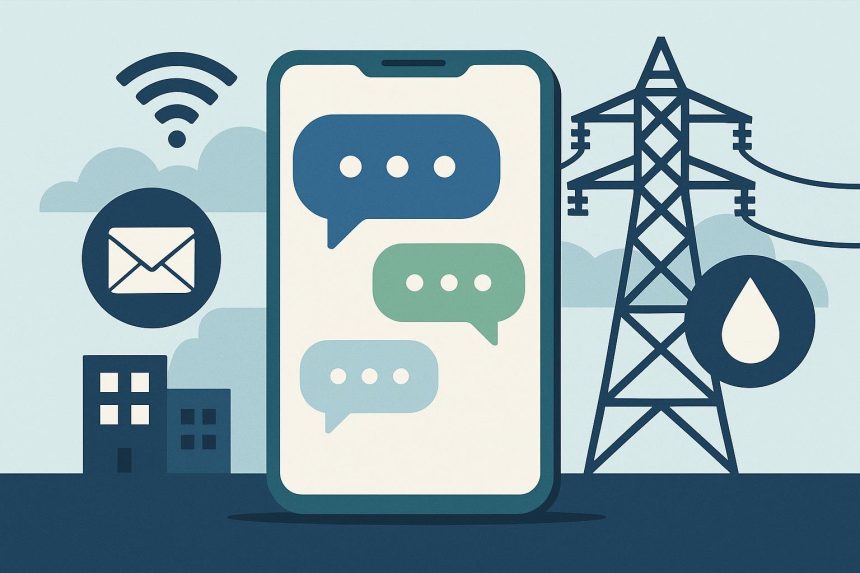Modern communication platforms can significantly strengthen utility providers’ customer relationships. They help companies match customer expectations and deliver meaningful interactions at every touch point. But what should you look for, and what are the top-rated customer communication platforms for utilities?
Features to Look for in Customer Communication Platforms for Utilities
When searching for a customer communication platform, consider finding one with these key capabilities.
Omnichannel Communication Capabilities
Modern communication platforms must deliver consistent, accurate and timely messaging across every channel a customer may use. This capability helps ensure customer safety and satisfaction.
Scalability and Reliability
Utility entities often have to serve many customers across vast service areas. As a result, they usually face unpredictable spikes in communication demand, especially during weather events or infrastructure failures. A customer communication platform should be able to scale effortlessly in these situations, handling numerous simultaneous interactions without system delays or downtime.
Reliability is just as important as scalability. Consistent uptime ensures that utilities maintain clear communication with customers when it matters most.
Integration With Existing Systems
Customer communication is only one aspect of what makes a utility provider operate smoothly. The most effective platforms integrate with existing systems, including billing software, customer relationship management software and outage management systems.
This integration ensures utility providers can send accurate, real-time updates about customer accounts, service status or energy usage. API support is one way to ensure interoperability across multiple systems and maximize their efficiency.
Data Security and Privacy Compliance
Utility providers handle highly sensitive customer information, which makes data protection a nonnegotiable requirement. A trustworthy platform must comply with regulations and frameworks such as but not limited to:
- National Institute of Standards and Technology Cybersecurity Framework
- General Data Protection Regulation
- California Consumer Privacy Act
- Texas Data Privacy and Security Act
Utilities should also implement strong encryption and access controls to protect personal data. These precautions help build trust and protect them from regulatory penalties and legal trouble.
Automation and AI-Driven Features
Automation and AI features can significantly improve communication efficiency and customer satisfaction. Automated workflows handle repetitive communications like bill reminders or outage notifications, freeing staff to focus on more complex tasks.
AI-driven tools add to this benefit by offering predictive insights that help utilities anticipate customer needs and personalize their approach. Natural language processing also allows chatbots and virtual assistants to handle routine questions, troubleshoot simple issues, or support multilingual customers.
What Are the Top-Rated Customer Communication Platforms for Utilities?
Utility entities can significantly improve customer communication with the right platforms. Consider these high-quality choices.
1. KUBRA
KUBRA is one of the most trusted, top-rated customer communication platforms for utilities. Known for its wide range of digital customer experience solutions, the business offers everything from outage communications and feature-rich mobile apps to billing and payments. Its omnichannel approach ensures consistent communication across email, SMS, push notifications and more.
A significant advantage of KUBRA is its natural language processing capabilities. Instead of having customers memorize keywords like “BAL,” “PAY,” or “STAT” to inquire about balances, facilitate payments, or inquire about service updates, they can type normally, and the system will process these interactions as if it were a live agent.
2. Oracle Utilities Customer Experience
Oracle brings decades of enterprise expertise to the utility sector with its Utilities Customer Experience platform. This solution enables a simple and intuitive experience through communication features and customer life cycle management.
Through its personalization features, it significantly boosts the quality of customer communication for utility companies. This platform also allows teams to leverage customer records to improve segmentation and targeting and to send hyperspecific messages that will best engage your audience.
3. Kapture CX
Kapture CX enhances utility customer support through automation and streamlined communication workflows. Its platform emphasizes omnichannel engagement, combining live chat, email and social media messaging into a unified interface that customer service agents can easily manage.
It offers real-time updates across multiple channels, informing customers about their billing history and providing tailored energy-saving tips and advice based on individual data. Kapture CX also uses bots and AI to the best of its ability to enhance personalization and customer experience.
4. Inspire Evolve by Quadient
The Inspire Evolve platform by Quadient is a communication management solution designed to modernize customer interactions. As a cloud-based, AI-powered platform, it provides control and visibility over each customer interaction, ensuring personalization across all platforms.
Inspire Evolve also highlights compliance in communication through the add-on feature Inspire Digital Vault. It automates document production, delivery and archiving, which can help reduce errors and maintain privacy.
5. OpenText Total Experience for Utilities
The OpenText Total Experience for Utilities provides a holistic approach to customer communication, combining analytics, personalization and omnichannel delivery in one platform. It helps utilities create, manage and distribute consistent messages across multiple channels.
OpenText also integrates AI features that enhance self-service experiences like natural language chatbots. Customers can access information on outages or billing without contacting call centers, reducing strain on support staff.
Key Considerations for Technology and Manufacturing Leaders
When adopting a new customer communication platform, you will likely need to consider other factors outside of its software features, including the following.
Cost of Acquisition
A new customer communication platform will cost money, especially at the enterprise level. Aside from the upfront acquisition costs, utilities must consider ongoing expenses like licensing, upgrades and maintenance. Employee training and systems integration may also add to these costs.
Before investing in new software, utility companies must conduct a thorough ROI analysis. Leaders should weigh the long-term value of a specific software against short-term budget constraints. The right platform can help save money in the long run by reducing customer service expenses, improving billing accuracy and enhancing customer satisfaction.
Vendor Reputation
Selecting a vendor with a proven track record in the utilities sector is important. Communication in this industry works differently from other fields — timeliness and reliability are critical for utility providers. Partnering with a reliable and reputable vendor improves performance and minimizes risk.
Leaders should review case studies, client reviews and independent reports to gauge performance in industry environments. Certifications and compliance with regulatory standards further indicate a vendor’s ability to deliver.
Ease of Deployment and User Adoption
Even the top-rated customer communication platforms for utilities can offer limited value if deployment becomes challenging or slow. Decision-makers should evaluate implementation timelines and resource requirements.
User adoption is another key factor. Platforms with intuitive interfaces, comprehensive documentation, and strong training programs allow technicians and staff to adapt quickly. The smoother the transition, the faster you can experience the new platform’s benefits.
The Top Trends in Utility Customer Communications
Communication in the utilities industry constantly evolves alongside new technology and customer needs. Understanding these trends can help enterprises adapt and address new demands.
Hyper-Personalization
More utility companies use AI and data analytics to deliver hyper-personalized customer experiences. Analyzing data points like demographics or consumption patterns allows providers to craft messages that resonate with individual needs.
Omnichannel Experiences
People now expect to communicate with utilities through their preferred channels, whether it’s Short Message Service (SMS), email, social media or mobile apps. Omnichannel platforms ensure seamless interactions, allowing users to start a conversation on one channel and pick it up on another without losing context.
End-to-End Self-Service
Online portals and AI-driven chatbots now empower customers to handle routine tasks like billing, outage reporting, and account management. This shift reduces call center demand and lowers operational costs. It also gives users the autonomy and convenience to resolve issues quickly without waiting for support staff.
Real-Time Updates
Reliability and transparency are critical in the utilities sector, and real-time updates are becoming a standard expectation. Providers often now use push notifications or SMS to inform customers about outages, restoration times and service changes. These timely updates reduce uncertainty and effectively manage customer expectations during critical events.
Investing in Modern Utility Communication
Customer communication platforms have become powerful tools for utilities to create stronger and more positive customer connections. Focusing on vital features while considering business implications can help utilities find the right platform to serve their customers best and make their jobs easier.
Lynn Martelli is an editor at Readability. She received her MFA in Creative Writing from Antioch University and has worked as an editor for over 10 years. Lynn has edited a wide variety of books, including fiction, non-fiction, memoirs, and more. In her free time, Lynn enjoys reading, writing, and spending time with her family and friends.















